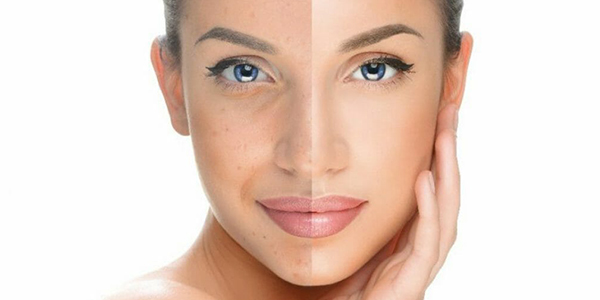Your skin gets its colour from melanin – a pigment produced by special cells (called melanocytes) in the skin. Unfortunately, when these cells become damaged – by the sun, for example, or by simply getting older – it affects melanin production. Excess melanin generally creates dark spots on the skin and is also referred to as hyperpigmentation.
But the good news is that there is a variety of topical hyperpigmentation products that can help you manage dark spots. So, let’s look at the active ingredients that deliver proven results.
Vitamin B3
Vitamin B3 is otherwise known as niacinamide. This is a vitamin that helps hydrate skin, treats hyperpigmentation, boosts skin elasticity, reduces redness, and works as an antioxidant that deters the formation of free radicals.
Niacinamide can even help your skin build a ceramide barrier – which is a good thing because ceramides are fatty acids called lipids that are naturally found in skin cells. A decent ceramide barrier will help the skin retain more moisture and is beneficial for all skin types, especially mature and sensitive skin.
Hibiscus extract
Studies have shown that Hibiscus syriacus ethanolic extract can stimulate collagen synthesis by 60% and accelerate wound-healing properties. Hibiscus extract is also packed with minerals, vitamins and antioxidants that will give your skin a youthful glow.
Licorice extract
Licorice extract contains liquiritin, an active compound that helps to eliminate existing melanin in the skin – which makes it perfect for hyperpigmentation products. Glabridin (also found in licorice) has been clinically proven to work effectively as a dark spot corrector.
Meet Celltone’s new Pigment Corrector range
If you liked our Brightening range, you will love our new Celltone products for dark spots. It is called the Celltone Pigment Corrector range and consists of a face wash, a day cream, and a night cream. We also created an optional serum (clinically and dermatologically proven to diminish dark marks and uneven skin tone) for an additional boost.
With continued use, this brand-new formulation will start showing noticeable improvements from just 14 days.
Celltone Pigment Corrector Face Wash
This invigorating cleanser contains hibiscus extract and Vitamin B3 (niacinamide) and gently cleanses the skin whilst removing impurities.
Celltone Pigment Corrector Day Cream
The sun can take a toll on your skin, since UV light damages DNA in the epidermis and can cause photocarcinogenesis and photoaging effects like dark spots. Therefore, we included some protection against that big ol’ ball of gas and made the Pigment Corrector Day Cream SPF 30. Hyaluronic acid and licorice extract in the Pigment Corrector Day Cream moisturise your skin and create a smooth, radiant complexion.
Celltone Pigment Corrector Night Cream
The Pigment Corrector Night Cream builds on all the goodness of the face wash and the day cream in this range. In it, you will find Vitamin B3 (niacinamide) and hyaluronic acid, because as you know by now, these will work well against dark marks and moisturise at the same time.
Celltone Pigment Corrector Serum
As an optional booster, you can use the Pigment Corrector Serum – a dark spot corrector with Vitamin B3 (niacinamide) and hyaluronic acid to target and combat areas with dark marks and uneven skin tone, whilst providing moisturisation to the skin.
Celltone’s new Pigment Corrector range is available at Dischem and Clicks.
Friendly reminder: Your skin is a complex organ and we all react differently to products, therefore, we highly recommend that you introduce new products one at a time.
Did you know there are different kinds of hyperpigmentation?
Hyperpigmentation is a common skin complaint and there are many different types with the most common being melasma, solar lentigines and post-inflammatory hyperpigmentation.
Melasma
Fluctuations in hormone levels are often to blame for a particular kind of hyperpigmentation known as melasma or chloasma. It is suspected that progesterone plays a major role in the development of melasma.
The development of melasma can also be pinned on your genetic predisposition, and it seems to be a problem more common in females than in males. Melasma also appears to be more prevalent in darker skin types than in lighter skin types, especially in parts of the world with high sun exposure.
Post-inflammatory hyperpigmentation
Dark spots that occur due to an injury or a skin condition that inflames the skin (like acne) are a type of hyperpigmentation called post-inflammatory hyperpigmentation. The skin reacts to the irritation by producing too much melanin and these kinds of marks can range from tan, brown and dark brown, to even blue-grey.
Solar lentigines (also called liver spots, sunspots or age spots)
Too much exposure to the sun is not good for your skin and we cannot stress the importance of using a good sunscreen enough. UV light is detrimental to various elements in the skin. We mentioned the fact that it damages your DNA in the epidermis, but UV radiation can also cause peroxidation of those helpful fat molecules, the lipids, which may cause the melanocytes to produce a surplus of melanin.
PLEASE NOTE: The information provided on this site is for educational purposes only and does not provide a substitute for professional medical advice.
If you have any questions about Celltone products for dark spots – you are welcome to #AskCelltone by sending us a WhatsApp message to: +27 83 123 4567.
List of references:
Are Natural Ingredients Effective in the Management of Hyperpigmentation? A Systematic Review
Hibiscus syriacus Extract from an Established Cell Culture Stimulates Skin Wound Healing


